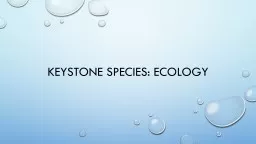

Definition a species on which other species in an ecosystem largely depend such that if it were removed the ecosystem would change drastically Examples Sea Otter Beaver Grey Wolf Acorn Banksia ID: 530416
Download Presentation The PPT/PDF document "Keystone species: Ecology" is the property of its rightful owner. Permission is granted to download and print the materials on this web site for personal, non-commercial use only, and to display it on your personal computer provided you do not modify the materials and that you retain all copyright notices contained in the materials. By downloading content from our website, you accept the terms of this agreement.
Slide1
Keystone species: EcologySlide2
Definition:
a species on which other species in an ecosystem largely depend, such that if it were removed the ecosystem would change drastically
.
Examples: Sea Otter, Beaver, Grey Wolf, Acorn Banksia
Types: Predators, Mutualists, Engineers
Not dominant species (dominant species is all of one species weighed together and equal the most out of all species)Slide3
Keystone Predator
Example Sea Otter:
Does not have to be the apex predator, orca’s prey on sea otters
sea otters eat sea urchins, sea urchins eat kelp holdfasts, so sea otters protect the kelp forests from damage.
The kelp provides the major backbone of the ecosystem (protection, primary food producer) so it is possibly the dominant species.
If the sea otter is not present the sea urchins eat all the kelp and totally wipe out the ecosystemThis is what makes the sea otter the keystone species in this caseSlide4
With Sea Otter
WithoutSlide5
Keystone Predator
Example: Jaguar
The jaguar, whose numbers in Central and South America have been classified as Near Threatened, acts as a keystone predator by its widely varied diet, helping to balance the mammalian jungle ecosystem with its consumption of 87 different species of prey
.
Any mammal that begins to thrive becomes the easy meal for the jaguar and as such its numbers decrease. This keeps species diversity high.Slide6
Keystone Mutualists
Keystone mutualists are organisms that participate in mutually beneficial interactions, the loss of which would have a profound impact upon the ecosystem as a whole
.
Example:
Banksia prionotes
(Acorn Banksia)At one time of year the acorn Banksia is the sole food source for honeyeatersHoneyeaters are the primary pollination facilitators in the regionWithout the acorn Banksia the pollinators will die and as such the pollinating plants of the area will die out totally changing the ecosystem.Slide7
With Acorn Banksia
WithoutSlide8
Keystone Mutualist
Example: Cassowary
Frugifore (fruit eater)
Spreads fruit seeds all over rainforest
Without it plants cannot spread out and competition increases
If this is the case species diversity will dramatically decreaseSlide9
Keystone Engineer
Example: prairie dog.
Prairie
dog burrows provide the nesting areas for Mountain Plovers and Burrowing Owls.
Prairie
dog tunnel systems also help channel rainwater into the water table to prevent runoff and erosion, and can also serve to change the composition of the soil in a region by increasing aeration and reversing soil compaction that can be a result of cattle grazing. Prairie dogs also trim the vegetation around their colonies, perhaps to remove any cover for predators. Even grazing species such as Plains bison, pronghorn, and Mule deer have shown a proclivity for grazing on the same land used by prairie dogs
. It is believed that they prefer the vegetative conditions after prairie dogs have foraged through the area.Slide10Slide11
Keystone Engineer
Example: American Beaver
transforms its territory from a stream to a pond or
swamp
affect the environment first altering the edges of riparian areas by cutting down older trees to use for their
dams, allowing younger trees to take their placethese dams change the riparian edges of streams and rivers into wetlands, meadows, or riverine forests. These dams have shown to be beneficial to myriad of species including amphibians, salmon, and song birds.Slide12
Summary
Keystone species
Doesn’t have to be apex predator but can be.
Its role must irreplaceable
Tends to not have any competition or very little for its niche
Quite often it is not discovered to be the keystone until it is too late, but then other ecosystems can be saved.Slide13
links
http://
www.youtube.com/watch?v=kEh4r4iQiBU
Prairie dogs
http://
www.youtube.com/watch?v=EUyxzAulkGk Cassowaryhttp://www.youtube.com/watch?v=D3W4OCnHyCs Sea Urchinshttp://www.youtube.com/watch?v=ArhWJts2sg8 Otters vs Crocodilehttp://
www.youtube.com/watch?v=VuMRDZbrdXc Beavers building a lodgehttp://
www.youtube.com/watch?v=tJ800AoqpdQ
Elephant knocking down tree
http://
www.youtube.com/watch?v=50tlF3kGbT4
Marula
fruit
https://
www.youtube.com/watch?v=ASJ82wyHisE
Sea otters vs urchins in kelp forests
https://www.youtube.com/watch?v=Uc7Ahp5--
eE
Sea otter using rocks to open clams
https://
www.youtube.com/watch?v=DBNYwxDZ_pA
Jaguar hunting Caimans
https://
www.youtube.com/watch?v=zUC4hjueTiM
New Holland honeyeater
https://
www.youtube.com/watch?v=CzUbgYT1yIU
Cassowary
Doco
https://www.youtube.com/watch?v=_
M1lK_aMszQ
Swamp loggers vs beaver dams
https://
www.youtube.com/watch?v=LU8DDYz68kM
Battle at Kruger